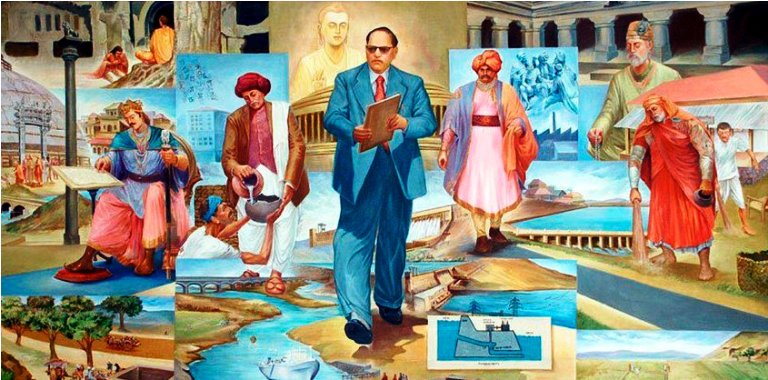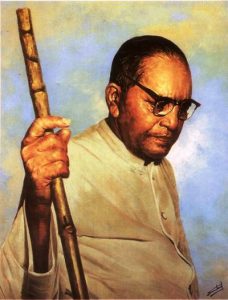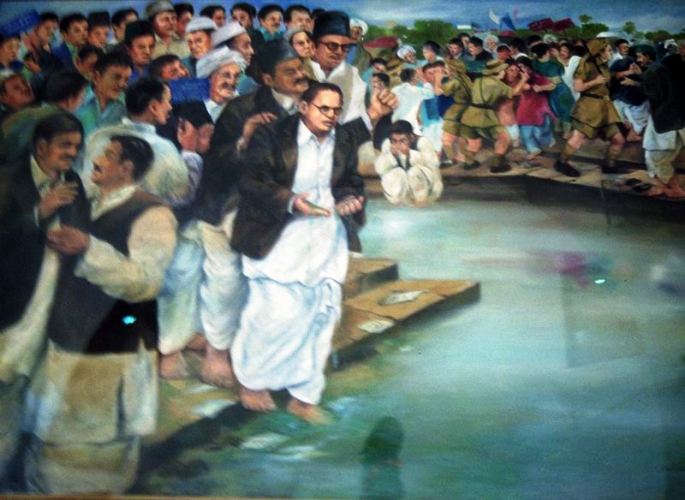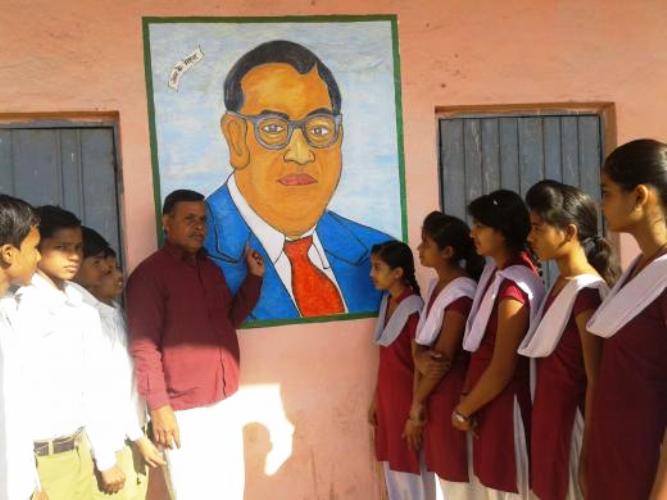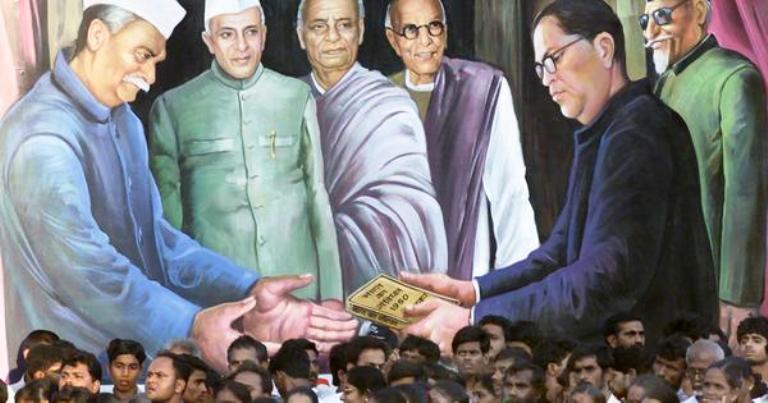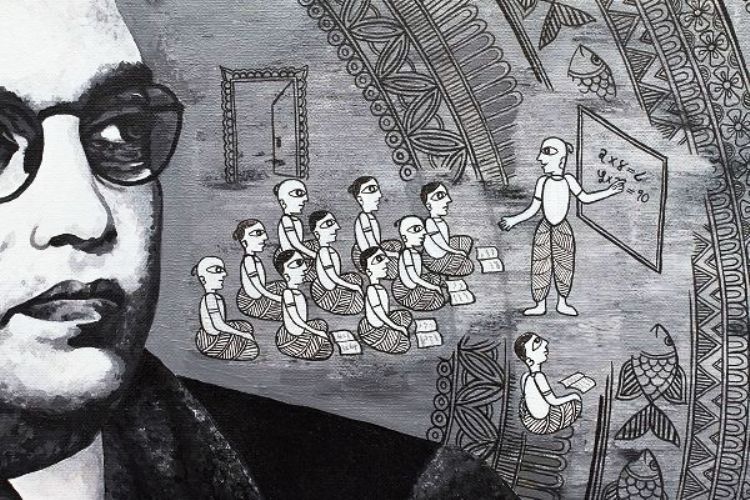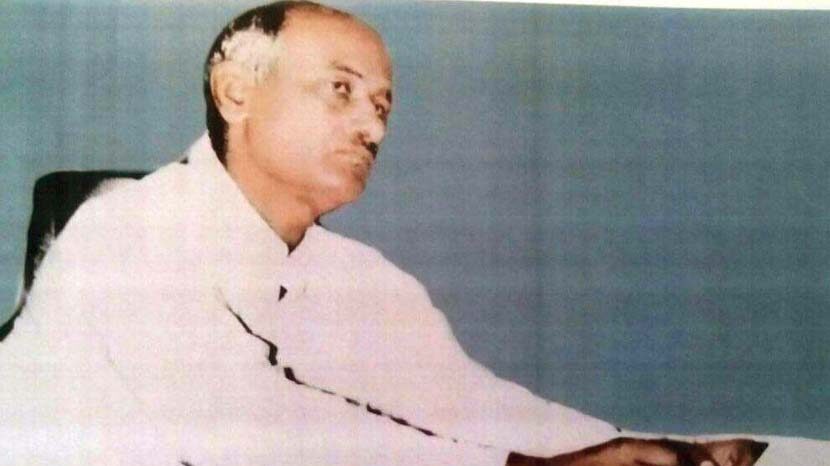Much as Dr B.R. Ambedkar is seen as a father of the Indian nation and an important father of anti-caste activism, fields of study also have their respective “fathers”. In the field of Peace and Conflict Studies (PCS), many scholars and activists often see Johan Galtung as such a father. We, in the field of PCS, regularly rely on Johan Galtung’s seminal typology of violence to understand how to develop peaceful systems. Galtung, in endeavouring to define peace, clearly understood that he first had to better understand its opposite – violence. In his seminal 1969 article entitled “Violence, Peace, and Peace Research”[1] he developed a typology of violence that is often represented as the three sides of an equilateral triangle. With direct, structural and cultural violence representing each side of this triangle, as if each side’s understanding was equally critical to realizing and actualizing peace, Galtung’s violence triangle simultaneously complicates and clarifies any path towards sustained positive peace. Galtung’s (1969) violence triangle helped develop the base understanding for him to coin critical concepts like “structural violence” and “negative and positive peace”, which have propelled much writing and thinking on peace research and social change over the last almost half a century. Galtung’s concept of structural violence, as it is linked closely with ideas of social justice, has particularly spawned much discussion and new ideas in not just the peace studies and conflict transformation discipline, but also other disciplines as well (see Farmer (2004), Ho (2007), Caprioli (2005), among others as examples of this critical and interdisciplinary discussion).[2] It is argued here that the pervasive and elusive reality of structural violence in the lives of anti-caste activists is what mobilizes an identity for change and builds an awareness of rights. In critically analyzing what Volkan (1997) calls the “chosen traumas” and “chosen glories” of the anti-caste movement we can read the narratives of Dalit activists at strategic opportunities for social and structural change of systems of violence. Though Dr Ambedkar may not have talked about the realities of caste in the language of structural violence, he understood that what we now call structural violence represents the foundational context to challenge in creating social change. But, how does one challenge the agent-less and systemic beast of structural violence? This, I believe, is the perennial question for those that revere Dr Ambedkar’s anti-caste activism.
Structural violence refers to systematic ways in which social structures harm or otherwise disadvantage individuals in a society. As systemic and structural, unlike direct or personal violence, this form of violence does not have a clear perpetrator. It is often hidden from those attempting to expose and eradicate it. One example Galtung (1969) himself uses to illustrate the concept of structural violence is the disease tuberculosis (TB). If a person died from TB in the 18th century one could not conceive of this as a form of violence because it might have been completely unavoidable – with no understanding of the disease, society had no ability to cure or control it. This lack of individual or collective agency marks such misfortune and suffering as distinct from any form of violence. On the other hand, if one died of TB today that would be an example of structural violence since we (as a global society) have the means to stop and treat TB.[3] Because we have collective agency (what Porter calls “the self-awareness to make self-chosen choices”[4]), any failure to act is a product of structural constraints (whether financial, logistical, or policy-oriented) that produce, for Galtung, an agentless form of structural violence. Note that this distinction has nothing to do with the subjectivities of suffering – no one can doubt that death by TB in the 18th century would produce equal (if not more) suffering as death by TB today. What marks today’s death as structural violence is the means with which we as a society have at our disposal to foreclose such possibility. Failure to use these means of foreclosure is an avoidable failure, even if its implementation might be structurally complex. For Galtung, it is the absence of structural and cultural violence that allows for the possibility of social justice, and eventually the ideal of positive peace. This, of course, assumes that direct violence and its historical legacies are managed, if not transformed.
While direct violence is often the instrument of control to maintain injustice in the present, it is structural and cultural violence that maintains the legacy of injustice into the future. In the words of Galtung “Cultural violence makes direct and structural violence look, even feel, right –or at least not wrong.”[5] Even though there is no type of violence that seems to deserve our primary attention over any other type of violence – it is clear that conflict transformation demands more than the absence of simply direct violence. In the case of the caste violence we see across India today, its eradication demands structural change, not simply justice enforcement. In short, we cannot definitively say that Galtung’s typology of violence exhausts the human need to understand violence. Each instance of violence (whether direct, structural, or some other type) is unique to the cultural context. For this reason – as the regular litany of new books about human violence should attest[6] – there exists no monopoly on a particular typology of human violence. Writers in the field of Peace and Conflict Studies, indeed, continue to grow our understanding of violence, and therefore, expand our means of potentially achieving a lasting positive peace. Such growth of knowledge is crucial to activists and scholars alike and demands critical attention in order to listen to the unique suffering of social actors as they narrate their lived experience of oppression and strive to meet their full potentials.
As example of this knowledge creation, recently Sara Cobb (2013) has written of what she calls “a new kind of violence”[7] – narrative violence. Rather than “new”, one might better call it “newly discovered”. Narrative violence is a special kind of violence that operates in the subtle spaces of storytelling and discursive communication. Cobb argues that “structural violence, by definition, is difficult to ‘story’ in that its existence does not seem to accompany specific history”.[8] As agentless and systemic, Galtung’s sense of structural violence maintains an elusive connection to particular characters and/or settings and therefore makes plotlines blurry and amorphous. An understanding of narrative violence helps to narrow this elusive disconnection as narrative violence creates what she calls a “state of exception”[9] for those embroiled in conflict. In describing this “state of exception” as something more than the impersonal and agentless structural violence described by Galtung, Cobb describes a context and people (or identity) that many Dalit rights activists would readily recognize as actively describing their everyday modern lives.
For Cobb, this “state of exception” is “a place where law has been used to create a place without law, a place that defies narrative itself”.[10] And the people that populate this “state of exception” – ie the victims of narrative violence – are “isolated and disenfranchised, they live in the shadows of the public sphere, their relation to state and community broken”.[11] The context and peoples that Cobb describes eerily map to Dr Ambedkar’s own descriptions of the Dalit/low-caste experience and resonate closely with modern descriptions of the experience of caste oppression. In privileging the present consciousness and memory of past events, narratives can help explain how an ongoing “state of exception”[12] has been “incorporated into the temporal structure of relationships”.[13] Thus, this “newly discovered” narrative violence provides a critical lens to understand caste oppression and anti-caste resistance. Applying this lens of narrative violence to caste-based violence gives life to the histories and present experiences of anti-caste activists.
In Annihilation of Caste, Ambedkar writes: “A caste has no feeling that is affiliated to other castes, except when there is a Hindu-Muslim riot. On all other occasions each caste endeavours to segregate itself and to distinguish itself from others.”[14] Living in such a state of exception for low-castes involves a constant process of drawing boundaries between their identity and that of others both higher and lower in rank status. In such context, the telling of stories can be understood as oblique or “hidden transcripts”[15] that challenge any lack of awareness of the low-caste social predicament. In other words, narrative violence creates the boundary conditions for identity, rights, and self-awareness that become, over time, powerful discourses to attempt to challenge, or maintain, the status quo. The “newly” significant type of narrative violence that Cobb identifies is at the core of all systems of oppression and the dynamics of this narrative violence are clearly evident in caste-based oppression, as well as, within the “talk” of social movements that are aimed at ending this oppression.
Narrative violence among anti-caste activists
Ambedkarite activists often tell hagiographic stories about of their patriarch, Dr B.R. Ambedkar. In my experience of meeting and talking with Dalit anti-caste activists there is an unquestioned reverence and respect for the life and work of Dr Ambedkar that can only be compared with a demi-god or modern pop-icon. This reverence is expressed through the telling of stories about Babasaheb’s life and work. Like most interactions with Ambedkarites, my own experiences interacting with Dalit diaspora Ambedkarites on the occasion of 125th birth anniversary was no exception to my previous experiences of this phenomenon of hagiographic storytelling. On this jubilant occasion, I spoke to an audience of Ambedkarites at Michigan State University and asked them to fully consider their own agency as speaking social agents. In being invited to give a lecture to Ambedkarite anti-caste activists there is always a balance between gently suggesting pragmatic action and providing critical analysis of the ongoing anti-caste movement. As should be evident by now, I do not think narrative is an inanimate and agentless fact of social interaction. Nor do I think that stories, or narratives, are just subjective expression of personal truths devoid of any social and political relevance for social change. Therefore, my focus in such “lecture” situations is often to draw attention to the stories that I hear activists themselves voice. As a social constructionist, I believe firmly in the power of stories to influence social and structural change and I am intentional about placing the agency for change among the people who have experienced, and in turn, tell (and retell) such stories. I have written elsewhere about the elliptical character of these stories and their ability to mobilize activism.[16] But, beyond movement mobilization what do stories do? How do they work to strengthen identity boundaries and build awareness of unmet rights and self-worth?
In the words of Michele Foucault: “People know what they do; frequently they know why they do what they do; but what they don’t know is what what they do does.”[17] In endeavouring to assist anti-caste Ambedkarite activists to understand what their stories do to change (and, at times, support) the social structure, my narrative analysis aims to empower activists to make pro-social change in society. Following Sara Cobb, I believe that narratives matter and have agency – “they have gravitas; they are grave. They have weight.”[18] Narratives themselves can act to change discourse, and thus, change systems. Having said that, analysis implies some level of understanding on the part of the analyst. My decade-long interaction with Dalit rights activists has developed some, albeit rudimentary, understanding of the conflict dynamics at play in India’s ongoing contentious tryst with caste. While narratives hold within them multiple interpretations and narrative violence has complex social and psychological sources, this should not deter us from attempting to develop further understanding through attention to narrative’s use. Narrative violence, in fact, implores us to analyze it – now that we have learnt of its existence we must think and act in ways that tap into narrative’s power to act for social good; to build “justpeace”. Below are a few examples that I believe show how stories can be both opportunity and constraint for change activists. Through a brief analysis of these formative identity narratives, I hope that the important opportunities in Dr Ambedkar’s life story and experience can be excavated, built upon, and reflexively mined for their inherent and complex opportunities to create lasting change.
Stories in Ambedkarite anti-caste circles
One of many hagiographic stories of Ambedkar’s life involves his 1934 trip to Daulatabad Fort in Maharashtra. [19] Travelling with a group of about 30 “untouchable” friends and arriving late and tired to these historical ruins, the party stopped to wash and refresh by a small tank of water that was near the entrance to the fort. Feeling newly refreshed as they entered the front gate of the fort, an old Muslim man came running to the entrance yelling “The Dheds [meaning ‘untouchables’] have polluted the tank!”[20] After some tense debate with the local authorities, the party was eventually allowed to see the ruins of the fort, but not without an armed guard to ensure that they did not “touch water anywhere in the fort”.[21] Dr Ambedkar’s own autobiographical sketch of this episode ends with the evaluative statement: “This will show that a person who is an untouchable to a Hindu is also an untouchable to a Mohammedan.”[22] Such a story is retold with disbelief and frustration by Dalit activists and recreated as street plays in many low-caste communities. But to what actual effect?
While Dr Ambedkar clearly told this story towards the goal of illustrating an evaluative judgment about the dehumanizing demerits of the caste system even outside of the Hindu fold, he also, in telling such a story, must have soon realized how little control he would have over this narrative going forward. Again in the words of Cobb “narrative authorship is partial and dependent” and, therefore, we often “arrive at narratives that we did not make.”[23] While such a narrative helps to build a collective identity as marginalized, it also paradoxically positions Dalits in identities that they have little control over. How followers and detractors use this story to make their own evaluative judgments and build support for their own identity concerns represents a crucial question for anti-caste activists pushing for social change. While this story clearly communicates the injustice and inhumanity of the situation Dalits consistently face, it also constructs their identity as distinct from, and possibly in opposition to, Muslims. Such a story, therefore, creates a paradox for Dalit activists. It creates an identity of “other” that supports and reinforces an identity and experience of self as “othered”.[24] While it underscores the inhumane and unjust realities of life as a Dalit or Scheduled Caste (SC), it also closes off dialogue with others (in this case Muslims and possibly other “downtrodden” and economically depressed potential allies) by strengthening in-group identity, as well as, portraying Dalits as either victims or a distinct and cohesive community as apart from various “others” in society. Either of these social positions leaves something to be desired for Dalit activists working for social transformation, and, therefore, the retelling of such a story acts to close off the narrative space to dialogue with others. This is not to suggest that Dalits not tell this story, but rather that it is the type of story that should be deployed selectively and strategically in tandem with positive identity and awareness education. Though not a strong example of Cobb’s sense of “narrative violence”, this narrative does little to challenge the perpetual narrative violence that Dalits face in the public sphere. It does little to “thicken”[25] the narrative life of Dalits. In fact, due to the ambiguity involved in Dalit listeners hearing such a story coming from Dr Ambedkar’s own experience, listeners get caught up in what Francesca Polletta calls “narrative ellipsis”[26] – a process in which the stories activists tell compel other activists to retell the story to better understand the ambiguous meaning of the events described. The story itself has a life. Failure to engage the story as a constantly changing system leaves activists unable to strategically use the story to its full potentials.
By reproducing the inexplicable inhumanity in such a story, the activist unwittingly reifies the community’s own sense of separated identity and victimization, and does little to open the opportunity for dialogue and narrative shift among others in the wider public sphere. In addition, high-caste detractors can, and do, use such a narrative to convince low-castes to stay within the Hindu fold reasoning that caste is not just a Hindu problem (which is indeed counter to Ambedkar’s own analysis of the caste system). In short, the narrative space this story opens, as it is currently deployed by Dalits, does little to create social agency and/or even the social justice equation for Dalits or low-caste communities. So how do anti-caste activists fashion stories that will better open the space for thick narrative that engenders authentic dialogue with others? This has been the perennial challenge for modern anti-caste activists. Failure to strategically develop and systematically deploy stories of oppression that devalue separateness of identity and simultaneously value liberty, fraternity, and collective awareness of injustice, has fractured and splintered the anti-caste movement. Such fracturing among anti-caste activists has left them unable to influence the hearts and minds of higher caste Indians.
Another more mainstream and consistent narrative that one hears when studying Ambedkarite communities worldwide is the nationalist story of Dr Ambedkar as the source/father of the Indian Constitution. Yet, such a dominant narrative has divergent meanings in different social communities and contexts. For Dalit communities, the faith in the rule of law is strong and India’s 1949 Constitution is a source of pride as the penultimate legal resource to ensure rights for the marginalized. This is why Ambedkar memorial statues throughout India show the Indian Constitution tucked under his left arm as a steadfast Dr Ambedkar points toward a desired egalitarian future. As the head of the drafting commission for the Constitution, Dr Ambedkar is seen by Dalits as the author of this important document, despite the more complex negotiated realities of his co-authorship. Even the more complicated and revolutionary aspects of Dr Ambedkar’s long career outside of government seem to be sidelined in nationalist narratives about him. Dalit friends have told me that it is the Constitution more than any other document that Ambedkar authored, including the revered Annihilation of Caste, which cements his anti-caste legacy. The narrative of Ambedkar as first law minister and nationalist hero trumps more complicated historical readings of him both within and outside Dalit communities. Indeed, it is within anti-caste activist circles, that an acritical reverence for Dr Ambedkar as a father of the nation, as well as the progenitor of a mass move to Buddhism, conspires to narrow the narrative impact of Ambedkar outside of Dalit communities. Still, in all strata of Indian society, a shallow collective understanding of Dr Ambedkar’s legacy and impacts exists. In heeding Cobb’s call for attention to narrative patterns[27] we must analyze not simply prevailing low-caste narratives of Dr Ambedkar and his followers, but also the narratives of high castes, if we hope to transform future-going narrative violence.
As an important father of the nation, Dr Ambedkar is remembered and memorialized by members of the privileged castes in an even more one-dimensional nationalist way than among Dalit communities. For the privileged castes, rather than the father of a democratic rule of law, or a social reformer, Ambedkar is one father (among many) of an India that is independent from outside rule. In the same league with Gandhi, Nehru, Patel, and other nationalist forefathers of the nation, in this perspective, Dr Ambedkar is a symbol of national unity and has little to do with caste oppression or social reform. Here, Ambedkar is a symbol of freedom and independence, but this freedom is nationalistic and amorphous – not tied to any one community, but to India as a unified and predominantly Hindu independent nation. In turn, Dalit reverence of Dr Ambedkar as an archetype for the rule of law is understood by privileged castes as simply supporting the nationalist narrative and in no way challenging Hindu privilege. In a sense then, as a source or a father of the Indian nation, Ambedkar legacy is mollified by both Dalits’ and privileged castes’ nationalistic narrative expressions about him. The reverence for Ambedkar is not lost, but rather transfigured into a call for national unity, as opposed to a critique of power. The dominant one-dimensional view of Ambedkar as nationalist father and author of the Constitution meld together in ways that work to mask more complicated and revolutionary narratives about him and forestall any constructive dialogue and/or criticism about his revolutionary ideas for social change.
The Babasaheb[28] of most Dalits’ imagination, a Dr Ambedkar as a revolutionary-change-agent and public intellect, are secondary narratives for the majority of caste Hindus. The nationalist narrative of Ambedkar as an important father of the independent nation has relegated the intellectual and social revolution he spurred to the domain of divided and contested histories. Such divided histories go unnoticed by the dominant castes and the more radical statements of Ambedkar have become sanitized in the public sphere. Dalits’ view of B.R. Ambedkar as revolutionary activist is largely invisible to many privileged higher castes. The fact is that the Dalit conception of Babasaheb, as a change agent and radical, is not a conception most high-caste Hindus ever encounter.
But, it is the politically powerful narrative of Ambedkar as the leader of a “Democratic Revolution”, to borrow the title of one of Gail Omvedt’s many books on the anti-caste movement,[29] that develops a future-going narrative and provides better opportunities than stories of Ambedkar’s own experiences of injustice to challenge narrative violence. While the nationalist narrative of Ambedkar as a father of the nation has certainly been co-opted by the Hindu right, its more complicated and “thick” retelling in anti-caste activist circles is critical to the process of creating lasting social change for the marginalized. More than stories of injustice, like the autobiographical account of Ambedkar’s experience in Daulatabad, stories of low-caste critique of the Indian democracy gain increased legitimacy through widening the circle of retelling. Low castes must, therefore, challenge the simple nationalist retelling of Dr Ambedkar’s constitutional drafting. The foundation of Indian democracy and the dreams of “incredible !ndia,”[30] which that democracy inspires, are based on caste. High castes must be made aware of this historical trauma and develop a collective awareness of the caste grounding of modern India. In narrating Dr Ambedkar as a revolutionary, and not just a nationalist, opportunities are created to revisit the prevailing, yet contested, history of India. In much the same way that a figure like Malcom X represents an under-told and revolutionary impetus of the civil rights movement, Ambedkar represents both a mainstream and revolutionary response to historical injustice. How activists tell the story of Ambedkar conditions possible responses, and points towards a desired future.
In Annihilation of Caste (1936) Ambedkar writes: “There are, many Indians whose patriotism does not permit them to admit that Indians are not a nation, that they are only an amorphous mass of people…Men do not become a society by living in physical proximity…”[31] Ambedkar’s critique of an Indian nation was conditioned by his personal experience of caste and empowered by an anti-caste reading of pre-modern Indian history. Without such a complicated and multi-layered critical history, Ambedkar’s relevance to many anti-caste activists is undermined and the opportunity space for any narrative shift on caste is limited. The task of activists embedded in the ongoing dynamics of caste contention is to endeavour to understand the narratives of the marginalized as teeming with “hidden transcripts”[32] ripe for intervention towards social change.
The nationalist story of Dr Ambedkar must not be retold without reference to his revolutionary critiques of caste oppression. Ambedkar’s nationalism when narrated as inseparable from his critical anti-caste activism, challenges a “thin” narrative of him as a national icon. More than India’s first law minister and patriotic organizer of law and order, in this telling, Dr Ambedkar is change agent both inside and outside the Indian government; he is simultaneously patriot and harsh social critic of a fallible India. More than a brilliant legal mind, Dr Ambedkar was also an educator on social exclusion and agitator for change! Anti-caste activists must not let the full scope or Dr Ambedkar’s legacy as a social-change agent and an organizer of government policy be forgotten, or denied by those in power. This more complicated narrative of Ambedkar’s life and work expands the narrative opportunities for Dalits and allows activists to invite others to take what Joseph Montville calls a “walk through history”[33] with them. In thickening the narrative of Ambedkar as a nationalist and revolutionary anti-caste activist, modern anti-caste activists live out Dr Ambedkar’s constant refrain to “Organize, Educate, Agitate”. Still, the fact remains that Ambedkar’s revolutionary voice often gets overlooked in mainstream Indian society, even by well-meaning liberals and progressive activists.[34]
The process of taking Montville’s (2001/2006) walk through history, inviting others to participate in, is important for anti-caste activists as it is works to educate the oppressors, while simultaneously developing a liberatory consciousness[35] and self-esteem among the oppressed. Thick narratives, such as Ambedkar as both nationalist leader and anti-caste revolutionary, represent opportunities to educate, build critical consciousness, as well as, create a paradigm shift in India’s thinking about history. While such thick narratives have difficulty spreading into more privileged segments of society, such spread is critical to the peaceful transformation of narrative violence.
Re-appropriating Ambedkar
Organize, educate, agitate! This is how Dr B.R. Ambedkar began and ended most of his public speeches. I believe that how we live out his bequest is through the telling of complicated stories of his life and work. Dr Ambedkar’s story is one full of plot twists, unearthly attainments, and great opportunity. Student of John Dewey, prolific author, India’s first law minister, agitator for separate electorates, the list could go on. Dr Ambedkar was an archetype in many ways – he was revolutionary in the sense that he was radically new and innovative for his time. If activists aim to keep him new and innovative, even today, sixty-plus years after his death, the stories they tell about him matter greatly. Unless activists work to complicate the story of his life and work, his legacy and full impact are done a grave injustice. Ensuring his revolutionary legacy requires more than memorialization through the thousands of statues erected in low-caste bastis across India. How activists make Babasaheb new and innovative for this time hinges on how they strategically tell his story; how much they complicate and interrogate it.
As Dalit communities move into the future – as each existent present moment is always new and pregnant with possibility – they must learn how to strategically tell stories about the past. Much of this strategy is developed through historic process of social learning.[36] In being attentive to the collective implications of telling stories, activists can lean on their collective social learning as a resource. This is where the work of Vamik Volkan (1998) can be extremely helpful for building positive identity. Volkan (1998), in writing about the post-war Balkans, writes about collective trauma and the way it is passed through collectivities and generations by leaders and speakers telling stories about “chosen traumas” or “chosen glories”.[37] A chosen trauma for Volkan “reflects a large group’s unconsciously defining its identity by the transgenerational transmission of injured selves infused with the memory of ancestors’ trauma.”[38] Chosen glories on the other hand are “the mental representations of a historical event that induces feelings of success and triumph”.[39] The stories of Babasaheb act as chosen traumas and chosen glories for anti-caste activists, but how do past traumas and glories of the Dalit rights movement inform the modern-day work for social change among anti-caste and marginalized community groups? For activists to be effective, they must attentively address this question. Unless social actors are aware of the cycles of harm and retaliation that they are caught up in, they are destined to repeat the cycles of contention. The fact is a narrative in conflict is an agent in itself, not just the data that researcher like me may choose to analyze or study. Being vigilant about the narratives we use, and critically reflective of those we hear and retell, requires active engagement and consistent analytical attention. While centuries of social learning have developed an “infrapolitics”[40] of resistance in low-caste communities, a similar social learning must be fostered in more privileged communities by the strategic selection and deployment of narrative storytelling.
What we know of conflict and past trauma, is that if you fail to address it, it will not go away. Its legacy will re-emerge in collectives and engender structural and cultural violence, and possibly, eventually, direct violence. It is incumbent on anti-caste activists to address conflict through critical attention to narratives, thus modelling the social justice vision they desire. Without vigilant critical attention, conflict narratives are allowed to control as opposed to being controlled. The privileged need to learn about Dalit collective trauma, and while it is not Dalit activists’ responsibility to teach this to privileged allies, it is incumbent on Dalit activists to model an awareness of the need for coexistence. The need still exists to re-story and re-appropriate Ambedkar’s history and ideology. Anti-caste activists can do this by strategically re-telling the Ambedkar narrative in a way that does not overlook the complex past traumas of the Dalit masses.
[1] Johan Galtung, “Violence, Peace, and Peace Research”, Journal of Peace Research, 6, no 3 (1969): 167–91.
[2] Paul Farmer, “An Anthropology of Structural Violence,” Current Anthropology, 45, no 3 (June 2004), 305-325; Kathleen Ho, “Structural Violence as a Human Rights Violation,” Essex Human Rights Review, 4, no. 2 (September 2007); Caprioli, “Primed for Violence: The Role of Gender Inequality in Predicting Internal Conflict” International Studies Quarterly, 49, no 2 (Jun, 2005), 161-178.
[3] Johan Galtung, “Violence, Peace, and Peace Research”, 168.
[4] Elisabeth Porter, Connecting Peace, Justice, and Reconciliation (Boulder, CO: Lynne Rienner, 2015), 47.
[5] Johan Galtung, “Cultural Violence”, Journal of Peace Research, 27, no. 3 (1990), 291.
[6] As recent examples see: David Nibert, Animal Oppression and Human Violence: Domesecration, Capitalism, and Global Conflict (New York: Columbia University Press, 2013); Mark Pilisuk and Jennifer Roundtree, The Hidden Structure of Violence: Who Benefits from Global Violence and War (New York: Monthly Review Press, 2015); and Jeff Lewis, Media, Culture and Human Violence: From Savage Lovers to Violent Complexity (Lanham, MD: Rowman and Littlefield, 2016); among many others.
[7] Sara Cobb, Speaking of Violence, 27.
[8] Ibid, 27.
[9] Ibid, 27.
[10] Ibid, 27.
[11] Ibid, 27.
[12] Sara Cobb, Speaking of Violence, 27.
[13] Vena Das, “The Act of Witnessing: Violence, Poisonous Knowledge, and Subjectivity”, 220.
[14] Bhimrao Ambedkar, “The Annihilation of Caste: A Speech Prepared by B.R. Ambedkar” in The Annihilation of Caste: The Annotated and Critical Edition, edited by S. Anand (New York: Verso, 2014), 242.
[15] James Scott, Domination and the Arts of Resistance: Hidden Transcripts (New Haven: Yale University Press, 1990), 183.
[16] See Rinker, Jeremy, “Why Should We Talk to People Who Do Not Want to Talk to Us? Inter-Caste Dialogue as a Response to Caste-Based Marginalization” Peace and Change, 38, no. 2 (April 2013), 237-262. See also Polletta, It was Like a Fever: Storytelling in Protest and Politics, 2006, 43-45.
[17] Quoted in Hubert Dreyfus and Paul Rabinow, Michel Foucault: Beyond Structuralism and Hermeneutics 2nd Edition (Chicago: University of Chicago Press, 1983), 187.
[18] Sara Cobb, Speaking of Violence, 3.
[19] Bhimrao Ambedkar, “The Dheds have Polluted the Tank” in Ambedkar: Autobiographical Notes (Chennai: Navayana Publishing, 2003), 23-25
[20] Ibid, 24.
[21] Ibid, 25.
[22] Ibid, 25.
[23] Ibid, 23.
[24] For a good discussion of how processes of “othering” and exclusion relates to protracted conflict, see Marc Gopin, Holy War, Holy Peace: How Religion Can Bring Peace to the Middle East (New York: Oxford University Press, 2002), 66-67.
[25] For this idea of “thickening” a narrative, I am indebted to both Sara Cobb (2013), op cit, and Clifford Geertz, The Interpretation of Cultures: Selected Essays (New York: Basic Books, 1973), 29-30.
[26] Polletta, It was Like a Fever: Storytelling in Protest and Politics, 2006, 43-45.
[27] Sara Cobb, Speaking of Violence, 99, op cit.
[28] This is the honorific name and reverent term that most Dalits use to talk about Dr B.R. Ambedkar. Its derivation signifies a fatherly leader and was used by Dr Ambedkar’s followers before his death, likely as a response the hagiographic term ‘mahatma’ used to describe M.K. Gandhi. For more on these honorifics see Joseph Lelyveld, Great Soul: Mahatma Gandhi and his Struggle with India (New York: Knopf, 2011), 211, among other writers on the Ambedkar Buddhist movement. For example see, Christophe Jaffrelot, Dr Ambedkar and Untouchability: Fighting the Indian Caste System (New York: Columbia University Press, 2005).
[29] Gail Omvedt, Dalits and The Democratic Revolution (New Delhi: Sage Publications, 1994).
[30] A prominent marketing initiative, Incredible !ndia, was conceptualized in 2002 by advertising consultant V. Sunil and Amitabh Kant, Joint Secretary, Ministry of Tourism for the Indian government. The “Incredible !ndia” logo, where the exclamation mark that formed the “I” of India was used to generating a 16 per cent increase in tourist traffic in the first year of the advertising campaign. See http://incredibleindiacampaign.com/ – accessed October 25, 2016.
[31] B.R. Ambedkar, Annihilation of Caste: An Annotated Critical Edition, edited by S. Anand (London: Verso, 2014) 243.
[32] James Scott, Domination and the Arts of Resistance, op cit.
[33] Joseph Montville, “Reconciliation as Realpolitik: Facing the Burdens of History in Political Conflict Resolution” in Identity, Morality, Threat: Studies in Violent Conflict, ed D. Rothbart and K. Korostelina (Lanham, MD: Lexington Books, 2006), 367–92; and Montville, “Justice and the Burdens of History”. In Reconciliation, Justice, and Coexistence, ed M. Abu Nimer, (Lanham, MD: Lexington Books, 2001): 129–44.
[34] For an example of this, see the writings of the Ambedkar Age Collective (2015) where the frustration over the appropriation of Ambedkar’s Annihilation of Caste is argued with little direct reference to his revolutionary voice. Ambedkar Age Collective, Hatred in the Belly: Politics Behind the Appropriation of Dr Ambedkar’s Writings (Hyderbad: The Shared Mirror, 2015).
[35] See Barbara Love, “Developing a Liberatory Consciousness” in Readings for Diversity and Social Justice (New York, Routledge, 2000), 599-603.
[36] See Albert Bendura, Social learning theory (Englewood Cliffs, NJ: Prentice Hall, 1977).
[37] Vamik Volkan, Bloodlines: From Ethnic Pride to Ethnic Terrorism (Boulder, CO: Westview Press, 1997), 48.
[38] Ibid, 48.
[39] Ibid, 81.
[40] James Scott, Domination and the Arts of Resistance: Hidden Transcripts, 183.
Forward Press also publishes books on Bahujan issues. Forward Press Books sheds light on the widespread problems as well as the finer aspects of Bahujan (Dalit, OBC, Adivasi, Nomadic, Pasmanda) society, literature, culture and politics. Next on the publication schedule is a book on Dr Ambedkar’s multifaceted personality. To book a copy in advance, contact The Marginalised Prakashan, IGNOU Road, Delhi. Mobile: +919968527911.
For more information on Forward Press Books, write to us: info@forwardmagazine.in
